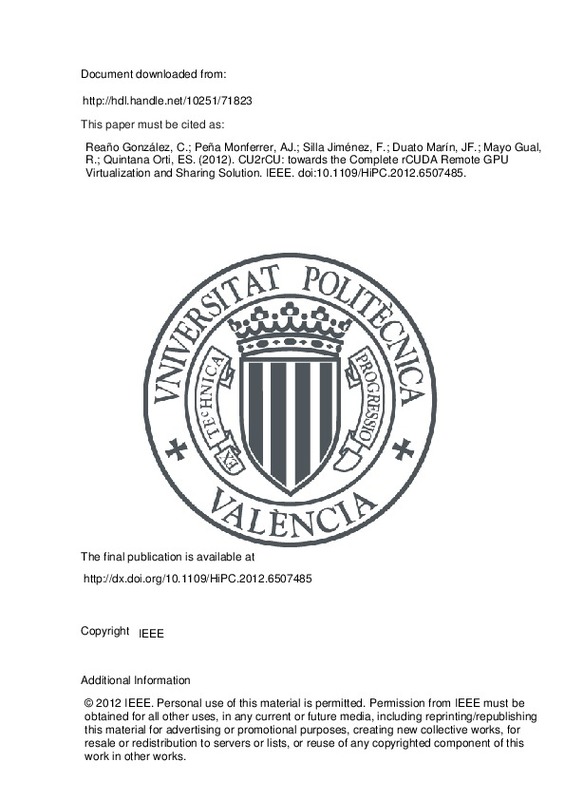Reaño González, C.; Peña Monferrer, AJ.; Silla Jiménez, F.; Duato Marín, JF.; Mayo Gual, R.; Quintana Ortí, ES. (2012). CU2rCU: towards the Complete rCUDA Remote GPU Virtualization and Sharing Solution. IEEE. https://doi.org/10.1109/HiPC.2012.6507485
Por favor, use este identificador para citar o enlazar este ítem: http://hdl.handle.net/10251/71823
|
Título:
|
CU2rCU: towards the Complete rCUDA Remote GPU Virtualization and Sharing Solution
|
|
Autor:
|
 Reaño González, Carlos
Peña Monferrer, Antonio José
Reaño González, Carlos
Peña Monferrer, Antonio José

 Silla Jiménez, Federico
Duato Marín, José Francisco
Mayo Gual, Rafael
Silla Jiménez, Federico
Duato Marín, José Francisco
Mayo Gual, Rafael

 Quintana Ortí, Enrique Salvador
Quintana Ortí, Enrique Salvador
|
|
Entidad UPV:
|
Universitat Politècnica de València. Departamento de Sistemas Informáticos y Computación - Departament de Sistemes Informàtics i Computació
Universitat Politècnica de València. Departamento de Informática de Sistemas y Computadores - Departament d'Informàtica de Sistemes i Computadors
Universitat Politècnica de València. Escola Tècnica Superior d'Enginyeria Informàtica
|
|
Fecha difusión:
|
|
|
Resumen:
|
GPUs are being increasingly embraced by the high performance computing and computational communities as an effective way of considerably reducing execution time by accelerating significant parts of their application codes. ...[+]
GPUs are being increasingly embraced by the high performance computing and computational communities as an effective way of considerably reducing execution time by accelerating significant parts of their application codes. However, despite their extraordinary computing capabilities, the adoption of GPUs in current HPC clusters may present certain negative side-effects. In particular, to ease job scheduling in these platforms, a GPU is usually attached to every node of the cluster. In addition to increasing acquisition costs this favors that GPUs may frequently remain idle, as applications usually do not fully utilize them. On the other hand, idle GPUs consume non-negligible amounts of energy, which translates into very poor energy efficiency during idle cycles. rCUDA was recently developed as a software solution to address these concerns. Specifically, it is a middleware that allows transparently sharing a reduced number of GPUs among the nodes in a cluster. rCUDA thus increases the GPU-utilization rate, taking care of job scheduling. While the initial prototype versions of rCUDA demonstrated its functionality, they also revealed several concerns related with usability and performance. With respect to usability, in this paper we present a new component of the rCUDA suite that allows an automatic transformation of any CUDA source code, so that it can be effectively accommodated within this technology. In response to performance, we briefly show some interesting results, which will be deeply analyzed in future publications. The net outcome is a new version of rCUDA that allows, for any CUDA-compatible program, to use remote GPUs in a cluster with minimum overhead.
[-]
|
|
Palabras clave:
|
Virtualisation
,
Graphics processing units
,
Middleware
,
Parallel processing
,
Power aware computing
,
Scheduling
|
|
Derechos de uso:
|
Reserva de todos los derechos
|
|
ISBN:
|
978-1-4673-2371-0
|
|
DOI:
|
10.1109/HiPC.2012.6507485
|
|
Editorial:
|
IEEE
|
|
Versión del editor:
|
http://dx.doi.org/10.1109/HiPC.2012.6507485
|
|
Título del congreso:
|
19th International Conference on High Performance Computing (HiPC 2012)
|
|
Lugar del congreso:
|
Pune, India
|
|
Fecha congreso:
|
December 18-22, 2012
|
|
Código del Proyecto:
|
info:eu-repo/grantAgreement/MICINN//TIN2009-14475-C04-01/ES/Arquitecturas De Servidores, Aplicaciones Y Servicios/
info:eu-repo/grantAgreement/GVA//PROMETEO08%2F2008%2F060/ES/Extensión de la tecnología de red hypertransport para la mejora de la escalabilidad de los servidores de internet/
info:eu-repo/grantAgreement/MICINN//TIN2011-23283/ES/POWER-AWARE HIGH PERFORMANCE COMPUTING/
info:eu-repo/grantAgreement/UJI//P1·1B2009-35/
|
|
Descripción:
|
© 2012 IEEE. Personal use of this material is permitted. Permission from IEEE must be obtained for all other uses, in any current or future media, including reprinting/republishing this material for advertising or promotional purposes, creating new collective works, for resale or redistribution to servers or lists, or reuse of any copyrighted component of this work in other works.
|
|
Agradecimientos:
|
The researchers at UPV were supported by the Spanish
MICINN, Plan E funds, under Grant TIN2009-14475-C04-01
and also by PROMETEO from Generalitat Valenciana (GVA)
under Grant PROMETEO/2008/060. Researchers at UJI ...[+]
The researchers at UPV were supported by the Spanish
MICINN, Plan E funds, under Grant TIN2009-14475-C04-01
and also by PROMETEO from Generalitat Valenciana (GVA)
under Grant PROMETEO/2008/060. Researchers at UJI were
supported by the Spanish Ministry of Science and FEDER
(contract no. TIN2011-23283), and by the Fundacion Caixa- ´
Castello/Bancaixa (no. P1-1B2009-35)
[-]
|
|
Tipo:
|
Comunicación en congreso
|







![[Cerrado]](/themes/UPV/images/candado.png)


